
Catherine Carrasco is a Junior studying Natural & Applied Sciences & Psychology at Florida International University. She is an executive board member of the Alpha Epsilon Delta & Psi Chi honor societies and an English tutor for the Refugee Assistance Alliance. During her free time, she enjoys practicing yoga and rollerskating.
Downtown as Text
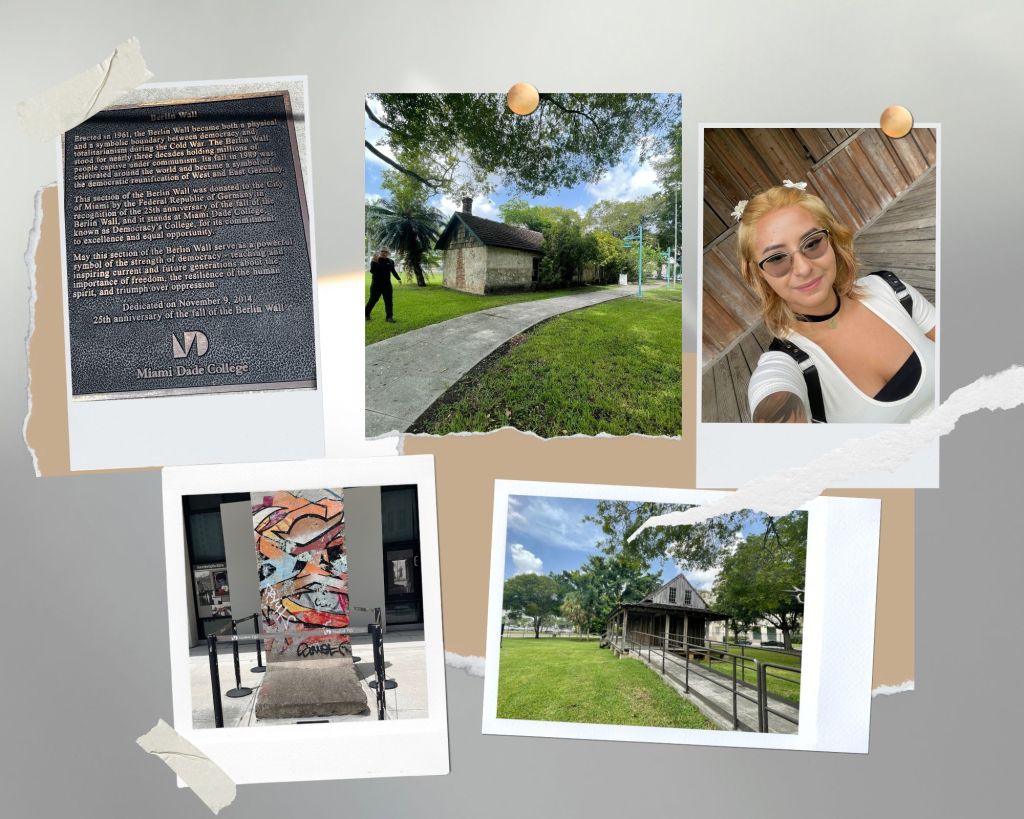
“A Melting Pot”
By Catherine Carrasco of FIU at Downtown Miami, 1 September 2021
As someone born and raised in Miami, my perception of the city’s origins only recognized historical moments through textbooks and not experience. Our walking lecture of Downtown Miami led to a deeper understanding of how the city’s melting pot of cultures came to be. The Wagner Homestead located at Lummus Park is a physical representation of the rich history created here. William Wagner was a Mexican War veteran who relocated from Georgia with his family and built the Wagner house. The Wagners lived contrary to many of the societal expectations of those times. As a mixed-race couple, they were known for befriending Native Americans during a time of war. I was able to sit on their front porch and imagine what social gatherings must have looked like for them.
One of the best moments of this trip was coming across a piece of the Berlin Wall at Miami Dade College. Here, we took a moment to discuss some of the effects of totalitarianism and the difference experienced in democracy. Many brave people risk their lives fleeing their hometowns searching for better work opportunities, education, and safety. Members of restricting government systems often face persecution for their religion or sexuality. Years ago, I researched the destruction of the Berlin wall and came across videos of people embracing each other with chunks of the wall missing. At the time, I was too young to comprehend what this moment meant for Berlin, but as an adult, I’m thankful for the piece of the Berlin Wall available at MDC.
Overtown as Text
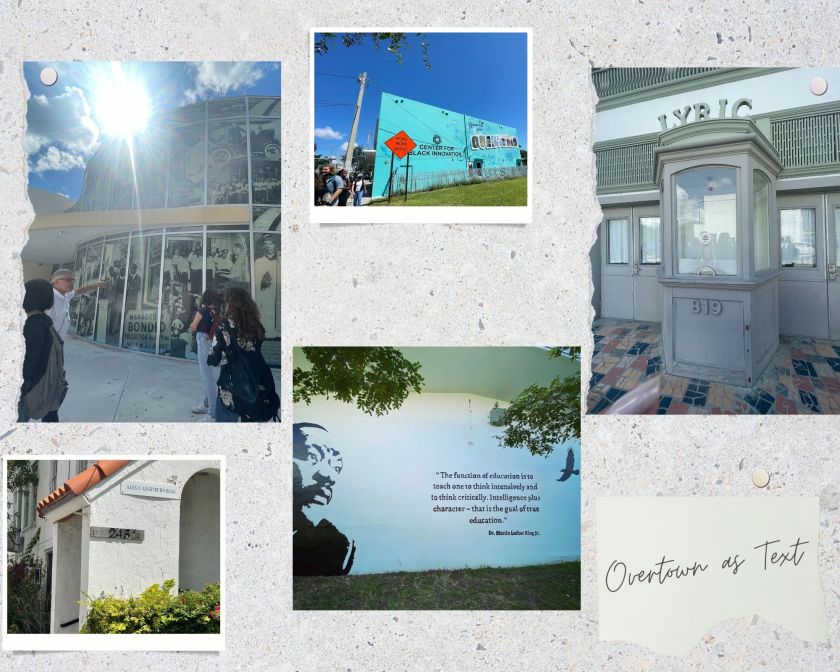
“Think intensely and critically”
by Catherine Carrasco of FIU at Overtown Miami, 15 September 2021
In 2019, I worked on a mural with a non-profit organization to install a mural of Martin Luther King Jr. at Miami Springs Junior High School. Alongside the mural is a quote from a paper by the late Dr. King that reads, “The function of education is to think intensively and to think critically. Intelligence plus character – that is the goal of true education.”
At the moment, it was an honor for me to participate in the project, and I felt the same admiration while walking into spaces in Overtown. There is so much of the city’s history that I’ve understood through textbooks but being in historic places continues to be a surreal experience for me. Walking into the Greater Bethel Church, we learned these were the same aisles and altars where civil leaders like Dr. Martin Luther King Jr. gathered to unify their communities. While learning about the history, we had the opportunity to listen to the stories of many community members. A significant recurring theme for many individuals was the change of life the addition of the interstate brought. Standing in certain spaces it’s clear to see the same systematic oppression at play in Overtown still occurring to this day.
Previously, I had no idea Miami had its own Little Broadway centered in Overtown. After the tour, I was happy to learn of the culture and history near The Historic Lyric theatre, but it was also heartbreaking to hear that this was the only area many performers were allowed to stay. During the tour, someone asked how emphasizing the way race played a role in history solves anything or unifies us as a community. It is difficult to comprehend how something as superficial as skin color has led to so much destruction. However, neglecting that it has been a significant factor in Overtown’s history de-emphasizes the courage and strength demonstrated by leaders in the community. Neglecting what led to segregation only offers the opportunity for it to occur again and doesn’t acknowledge the amount of courage and strength demonstrated during a period when it was needed most. The process reminded me of the rest of the paper by Dr. King, where he emphasizes the importance of thinking scientifically and weighing out what is the truth from untruth.
Vizcaya as Text
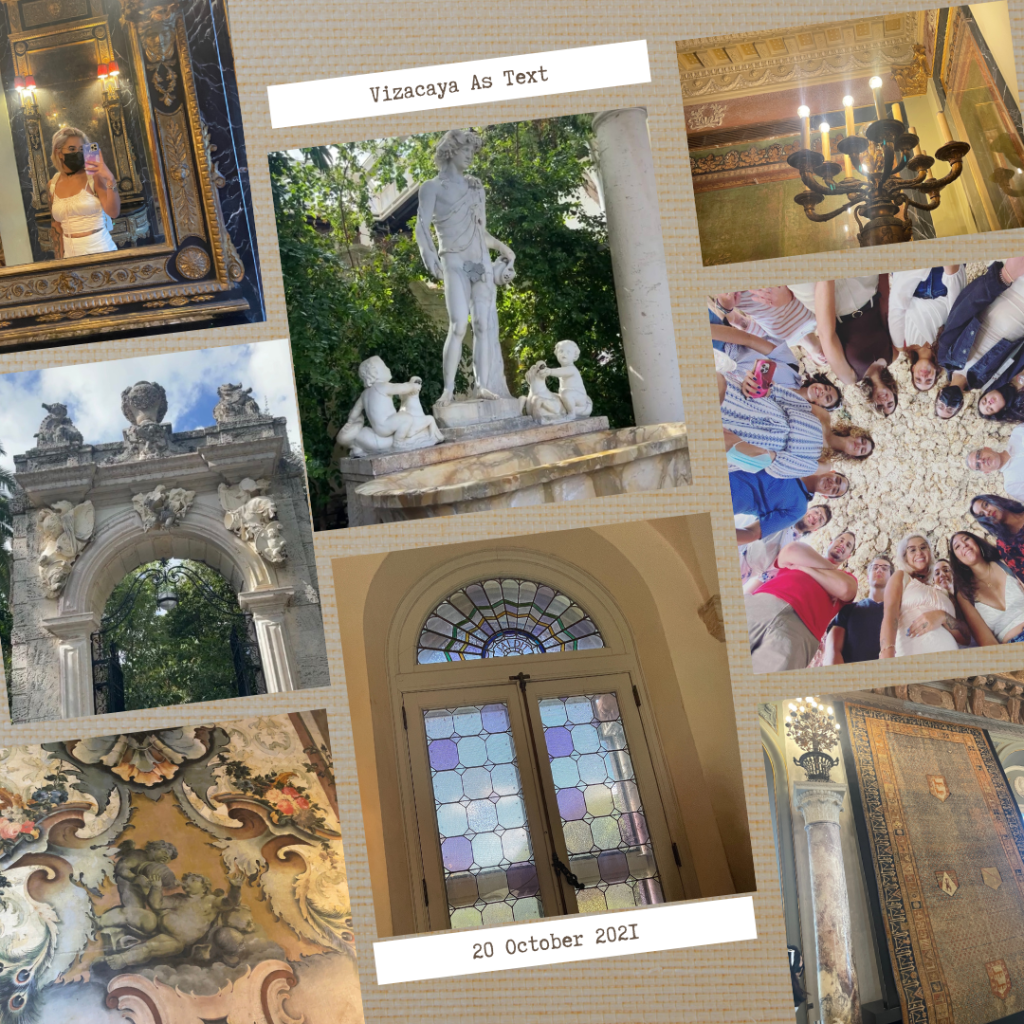
“A Self-centered God”
by Catherine Carrasco of FIU at Vizcaya Museum & Gardens, 20 October 2021
My first experience at Vizcaya Museum and Gardens was unforgettable. Entering the different rooms, I caught glimpses of what the process of constructing this beautiful estate must have entailed. There is a gorgeous arch on Entrance Road leading up to the main house and the first thing we learn about James Deering is he often took pieces of concepts he liked and made them his own. Vizcaya’s landscape must have been even more difficult of a place to upkeep in 1912. Surrounded by mangroves, a moat, and manicured gardens make it appear perfect from the outside looking in.
The Museum truly embodies some of the characteristics that make Miami so attractive to visitors. Miami is known to be one of hedonism and vices, and as we walked into the main house, the first statue served as a reminder of that perspective. Dionysus was known as the God of wine and pleasure. Here we find he greets visitors at the door. He was also known to be a self-centered God and similarly, James Deering appears to have been a man with unlimited resources whose need to showcase his extravagant taste led to the construction of this incredible place. We see this theme repeating itself throughout the art and architecture of the tour. “J’ai dit” loosely translated as “I have said” is engraved on the stained glass leading upstairs.
I found the Neoclassical room to be the most aesthetically pleasing, but the drastic differences were almost comical. Each room jumps from French to Asian themes and borrows content from various cultures, but as a whole, there is no real structure. However, this doesn’t take away from Vizcaya’s charm as its beautiful designs made it a place I hope to visit and learn more of in the future. I’m grateful to learn about its history in this way as I’m given insight into two different worlds. As awe-inspiring as it is, it’s difficult to imagine the type of labor that must have been demanded of blacks in the earlier twentieth century and the differences experienced within social classes.
South Beach as Text
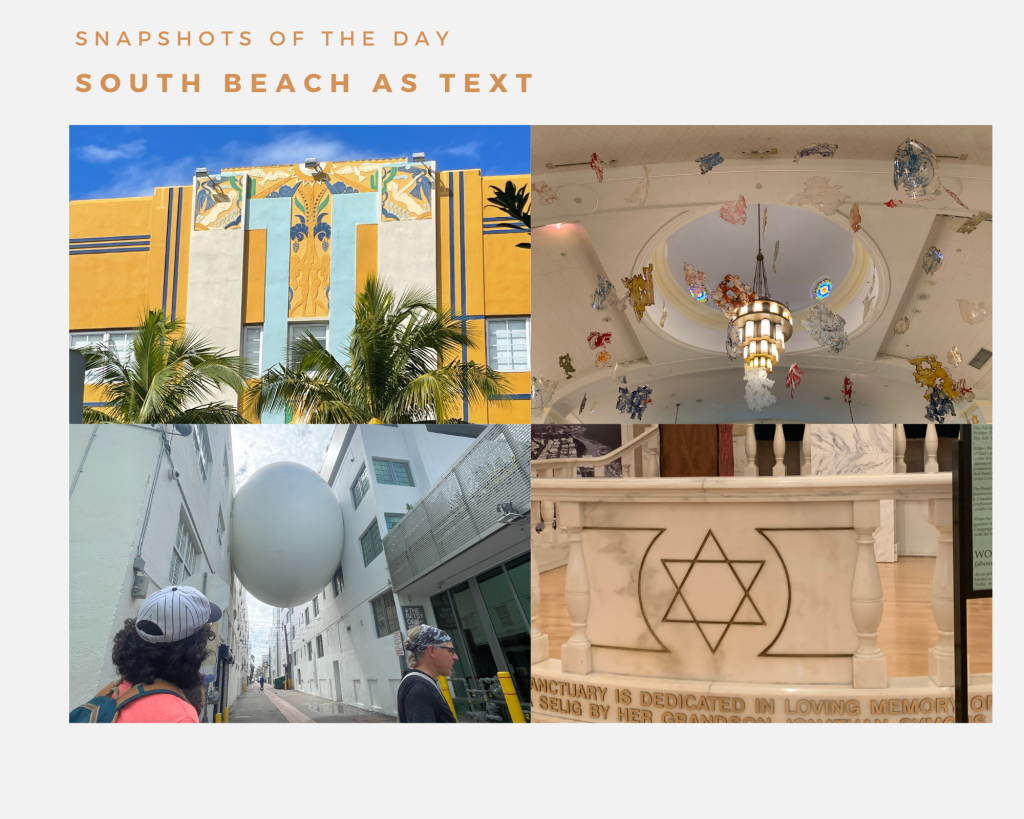
“Art Deco Miami”
by Catherine Carrasco of FIU at South Beach, 04 November 2021
Out of all our walking lectures, it was in the South Beach walking tour that I learned the most about history and segregation. Walking down the streets of Ocean Drive, it’s clear to see why this destination is a popular tourist attraction with its captivating structures and colorful artwork. Some of the facts about the art and location were unknown to me. Art deco, for example, takes influence from the past as well as futuristic features from machines. Another fact I wasn’t aware of is the history of the beach itself, once filled with mangroves and the way sand is brought into the city to sustain what we now know as South Beach. This specific location is easily accessible on public transportation making it an ideal place to visit. One significant takeaway for me from our class has been learning to navigate public transportation. I often skate, bike, or drive in my car to arrive at most of my destinations. Yet, I’ve lived in Miami my entire life and hadn’t had the opportunity to learn about the public transportation routes. These days I feel more equipped to take buses or the MetroMover on my own because of our experiences in class.
I’ve learned plenty about the segregation and discrimination the Bohemian people faced in Miami during the 1900s. However, I was not aware of the discrimination the Jewish people dealt with as well. A small group of classmates & I arrived a bit early at the Jewish Museum and our wonderful tour guide began sharing some incredible stories about Carl Fischer. Fisher not only had a vision for South Beach but he later attempted to recreate a similar getaway up North. However, he failed at this venture. It’s safe to assume this might have been due to the differing climates in both locations.
As a religious person, I found the art at the Jewish museum to be exceptionally beautiful. Anything with a religious undertone is interesting to me, but the most intriguing of the Jewish communities is its use of symbolism in their art. A quality like this is not portrayed as often in Christianity.
Rubell Museum as Text

“Artistic Influence”
By Catherine Carrasco of FIU at Rubell Museum on 24 November 2021
The Rubell Museum is the first private collection I’ve visited, and as an avid art enthusiast, it’s my favorite museum in Miami so far. So often, I’ve heard of contemporary art but never fully understood it or had an artist explain its meaning to me. Immersive exhibits such as the infinity rooms are some of the most interesting, and the Rubell Museum offers that in more ways than one.
Yayoi Kusama’s exhibits offer visitors insight into oneself as you can see yourself reflected in many forms. As the story of Narcissus goes, he was so in love with his reflection that it also turned into his greatest downfall. Even though some of the exhibit names imply a similar trajectory, such as Narcissus Garden, I find art like this refreshing as our most significant reference point to experience the world is oneself. The way we interpret situations, life, and art all derive from this particular point.
Overall, I find the best part of contemporary art to be its ability to resonate deeply with the viewer. So much of our current and cultural issues are addressed throughout the museum, as seen through artwork by Robert Colescott and Casja Von Zeipel. For example, in Colescott’s Adam and Eve, we can see a person of darker complexion looking at a man and woman in love, almost as if it’s something they cannot experience themselves. It reminded me of the secret gardens at Vizcaya where secret lovers met to hide their affection.
Zeipel’s work depicted influencers in deformed ways, which I interpreted as some of the present-day issues with identity brought on by social media. It isn’t easy to discern what is accurate online, and the room filled with her art represents that. A perfect example of that is the work by Barbara Kruger. Supreme, the brand, has been using the red text box with white letters, typical of her art, and capitalizing on it for many years. The brand itself is advertised as a luxury brand but unfortunately does not pay homage to the artist in any way. The concept of consumerism is represented in much of the original artists’ work, and it’s a shame to see it used in this way.
The experience of the Rubell Museum gave me a deeper insight into contemporary art. I enjoyed the way Keith Haring’s room tackled issues of sexuality in a unique way that I previously had not noticed in his more mainstream work.
UNTITLED as Text
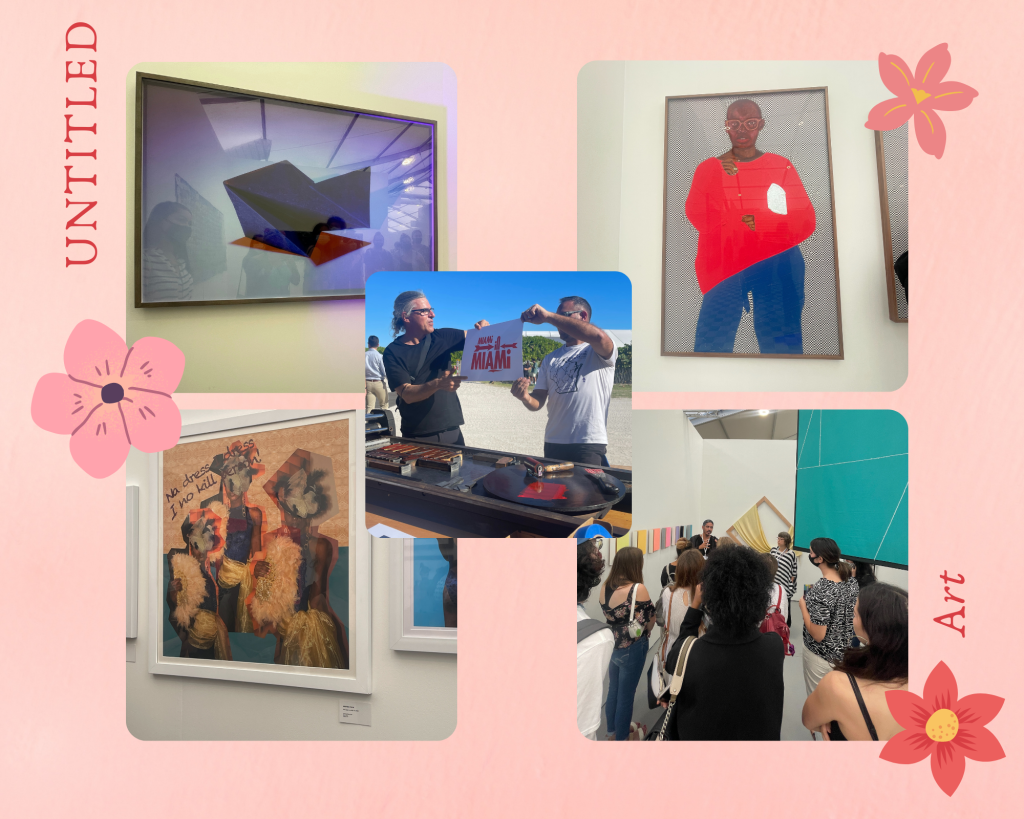
“Intro to Art”
By Catherine Carrasco of FIU at UNTITLED ART on 01 December 2021.
Initially, our class met Chris at the Site Lab on the beach, where he was using a letterpress machine to create designs right on the sand. Professor Bailly suggested we were impressed by the technique because the process had become obsolete. Advancements in technology have made it easy to rely on screens, but creating with your own hands will never be overrated. Chris mentioned having to let go of expectations throughout the creative process, which is excellent artistic advice.
The first booth we visited belonged to the Emerson Dorsch Gallery. Here we met Brook Dorsch, who shared his featured artist’s works represented their native home somehow. I asked about the work by Felecia, and Brook explained they were origami figures created on slightly reflective paper and covered in graphite. Inspired by the lava in Hawaii, Felecia took the pieces to a studio, shined blue light on them, and finally photographed them. The orange underneath appears painted but are shadows created by the light and reflective paper.
One of the benefits of an art fair such as UNTITLED is the exposure to all the international artists. We met Victoria of Gallery 1957, who shared with us artwork by an artist named Serge from Ghana. The photo I took of Serge’s work (top right) is made on a corkboard and covered in duct tape. From farther away, it isn’t easy to see the duct tape. It’s something I might not have noticed if Victoria had not mentioned it. She also shared 1957 is the year Ghana gained its independence and how the gallery got its name which I found remarkable. She also described some of the hassle associated with importing art and how certain materials are not allowed into the United States. Wood, for example, cannot be imported from Africa.
My favorite booth featured Nigerian artists who touched base on current societal issues relevant to their culture. For example, I found the artist who focused on drag intriguing because the work implies a murderer received the same treatment as those who dress up. I enjoy when artists act as advocates through their art.
UNTITLED was an incredible opportunity to learn about artwork, how its curated, and some of the challenges that often arise organizing an art fair.
Deering as Text
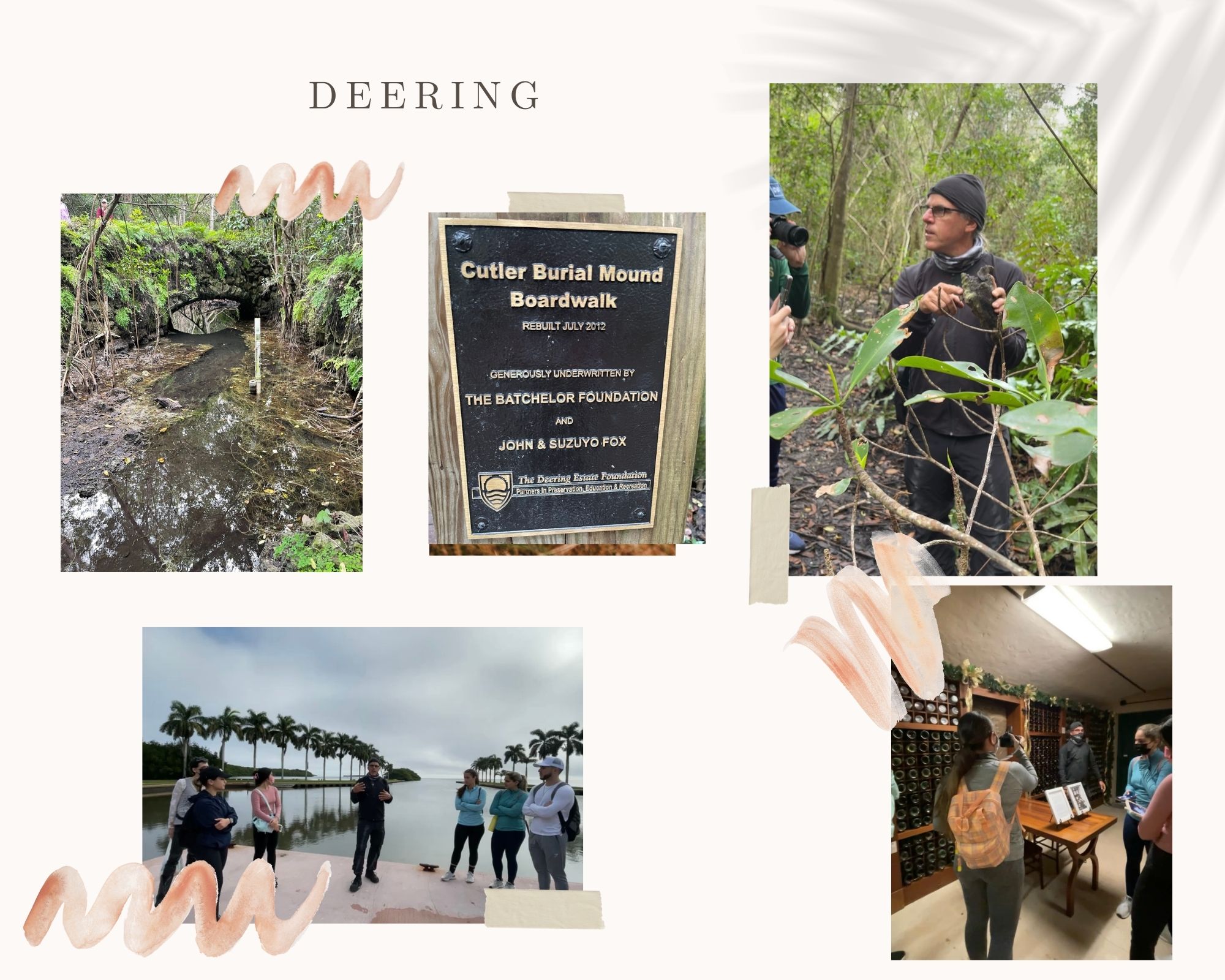
“History of the Tequesta”
By Catherine Carrasco of FIU at the Deering Estate, 02 February 2022
Our first walking lecture brought our class to the Deering Estate, which I had previously explored with Professor Bailly as part of his Miami in Miami class. However, the focus was on a cleanup effort on Chicken Key, a mangrove island found on the estate. Today’s lecture allowed us to explore the other areas and ecosystems found at the site. Our tour began at the Stone House, where we explored Charles Deering’s hidden wine cellar. It was illegal to purchase and transport alcohol during the Prohibition Era, but families like the Deerings could bypass those regulations due to their resources. The reality of situations like this one is that money plays a role in what is genuinely considered illegal.
My teachers made no references to the Tequesta tribe or even mentioned the existence of the Tequesta peoples throughout grade school. Yet, recognizing their practices and way of life is essential, especially to a native such as myself. It’s one of the reasons I preferred learning about the tribe and exploring the areas they once lived in while on the site. We explored the Cutler Creek Bridge and Tequesta Midden, where we observed one of the unique features found here; the intersection of freshwater and saltwater. We also came across shells and tools, which Bailly explained was common to see here. It’s easy to tell whether one of the shells found belonged to the Tequesta tribe. They used to drill holes in them to allow greater access to the inside and diversified their uses. However, the Spaniards were not privy to the practice and often smashed the shell instead.
Visiting the Tequesta Burial Site was a special moment for me because I learned the Miami Circle used to be a burial mound during a tour of Downtown last semester. There was no recognition of the community that used to live there and instead was being used as a sort of dog park. I was deeply disturbed to see that and know that most natives probably have no fundamental knowledge of what happened to the people whose loved ones were laid to rest there. It’s bothered me since, and I’ve taken the opportunity to speak to others about it, just to spread awareness of its history. At the Deering Estate, however, there is a Tequesta Burial mound with the remains of several tribe members. We walked on the boardwalk, and I was relieved to learn of the efforts taken to preserve its history. Another part of history I’ve been fascinated by is the architectural influences of other cultures like the Moors. These influences are found on structures throughout the Deering Estate, which I expect we’ll find much more of in Spain.
Coral Gables as Text

“Mediterranean Revival”
By Catherine Carrasco of FIU at Coral Gables 13 February 2022
In the 1920s, George Merrick had the vision to develop what is now known as the city of Coral Gables. The Mediterranean Revival architecture of Coral Gables has fascinated me for years, and diving deep into the architectural style provided a new perspective on the city’s history. The style is characteristic of arches, iron-wrought accents, spiral columns, and courtyards. An important aspect is the Mudejar style art present in some regions of Coral Gables, as seen in the Biltmore’s ceilings. Aside from the art styles, George Merrick was an idealist who was relentless and strategic in creating this neighborhood. One of the first structures built here was the Coral Gables Congregational Church in honor of Merrick’s father, a Congregational Minister. During the 1920s, a church and school were seen as essential parts of the community. The elementary school (now Coral Gables Prepatory Academy), church, and Biltmore are all on the U.S. National Register of Historic Places. Merrick hired Phineas Paist, one of the architects who made his dream a reality. Paist previously worked with Paul Chafin designing what is now known as Vizcaya’s Museum & Gardens. Both the Biltmore Hotel & Alhambra Towers contain the Giralda bell tower replicas located in Seville, Spain. Much of the architecture takes inspiration from Moorish culture due to the region’s history.
“History of Andalusia.” Encyclopedia Britannica, Encyclopedia Britannica, Inc., https://www.britannica.com/place/Andalusia-region-Spain/History.
“History of the Building.” MOAD, https://moadmdc.org/freedom-tower/history-of-the-freedom-tower.
Vizcaya as Text

“The Conflicting Nature of Vizcaya”
By Catherine Carrasco of FIU at Vizcaya Museum & Gardens 18 February 2022
In 1910, James Deering purchased 130 acres of land, where he began his construction of the Vizcaya Museum & Garden. Originally the estate was meant to be experienced from the Courtyard, and much of the artwork found within the home details Deering’s early vision for Miami. His designs challenged many of the subjects we still tackle today, from architecture to art. A repeating theme found at Vizcaya is cultural appropriation. At the garden entrances, triumphal arches lead the way inside. Traditionally, Romans built these arches to represent military victory. However, James had no association with the military, yet he had the resources to construct whatever he pleased, regardless of tradition. Near the arches are Islamic-inspired fountains which are traditionally a place of contemplation for those within the culture.
Interior design styles vary from Rococo to Neoclassical to Baroque inside the estate. Dionysus greets visitors at the back entrance and putti decorate the walls representing temptation in the music room. The construction of the Museum and gardens occurred during a period in which Miami was nothing like it is today. Details and symbols found throughout the home express how Deering predicted Miami would transform into the beautiful getaway it is known as today. Without a doubt, beauty fills the estate in every corner. However, questions regarding our society arise while visiting, such as racial equality and ethical practices. Is it wrong for Deering to decorate his creation without connection to the original cultures that invented these traditions? Today we see much of the Mediterranean-style beauty found at Vizcaya serving as a source of inspiration for the surrounding neighborhoods. Paul Chalfin, the estate’s original architect, later contributed to the design of Coral Gables, now known as the City Beautiful. Not much in these areas acknowledges the Bohemian workers who built the city during a time of intense racial inequality and segregation. However, the Museum’s efforts to educate the community of its rich history are admirable, making it one of Miami’s most peculiar places to visit.
“Stories of Vizcaya.” Vizcaya, Vizcaya Museum & Gardens, https://vizcaya.org/stories-of-vizcaya/.
River of Grass as Text
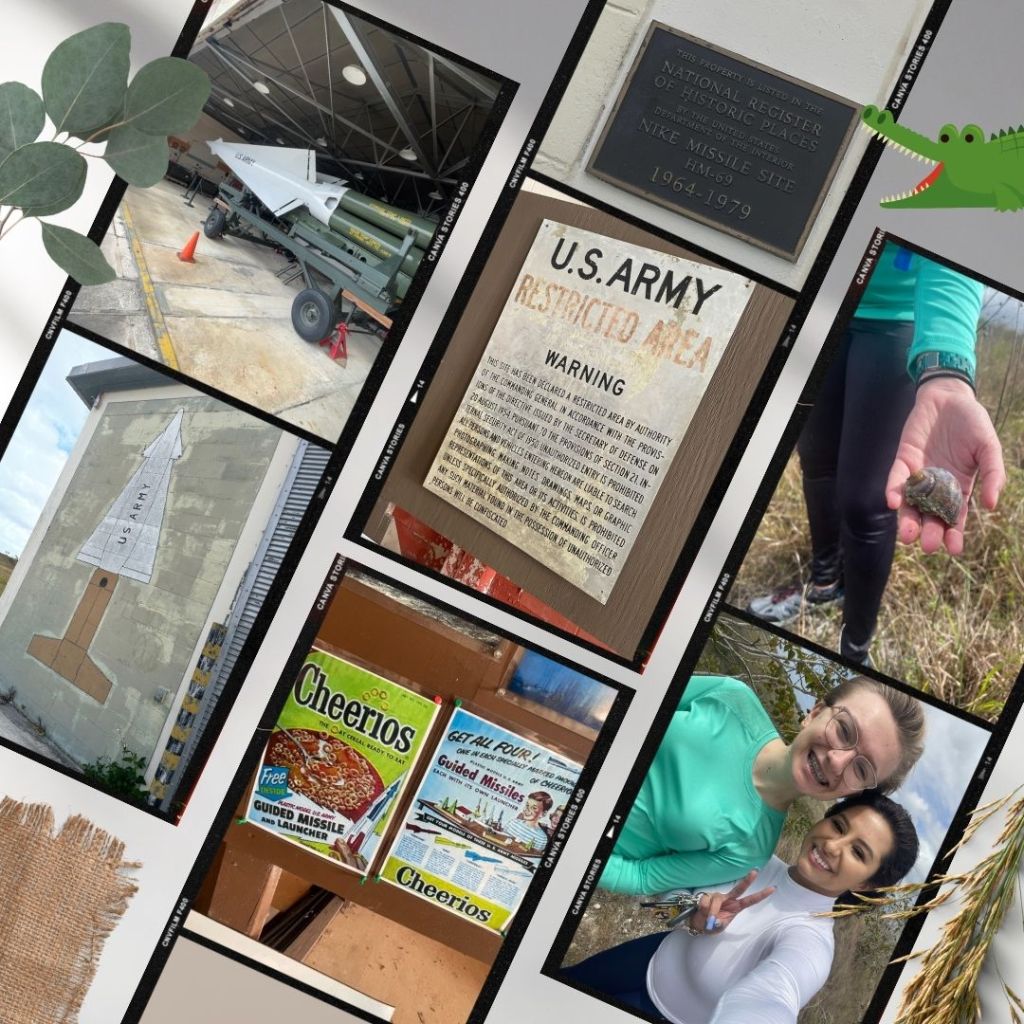
“Remnants of October 1962”
By Catherine Carrasco of FIU at Everglades National Park 22 February 2022
Some historical artifacts exist as a reminder of what could have been. For example, many items found at the Nike Missile Site point to a period in U.S. history that could’ve been catastrophic but ultimately turned out to be a blessing in disguise. The Nike Hercules Missile is one of these incredible artifacts found at the Everglades National Park. The antiaircraft rocket is the second surface-to-air missile of the Nike series created to protect the nation from aerial attacks. As tension between political leaders continued to rise, our government strategically placed military bases in areas of most benefit. In 1961, the Kennedy administration orchestrated an invasion of Cuba to overthrow former Cuban leader, Fidel Castro. The CIA sent approximately 1,500 Cuban exiles to invade the island, but Castro’s military defense defeated them. In response to the attack, Cuba partnered with Soviet leader, Nikita Khrushchev, setting up Russian missiles in October 1962. President John F. Kennedy did not take the threat lightly and spent the following days determining the best course of action. The moment in time is known as the Cuban Missile Crisis, as a different decision could have led to nuclear war. The political leaders ultimately reached an agreement, and Khrushchev agreed to remove the missiles if the United States decided not to invade Cuba. The Soviet Union also considered the existence of American missiles in Turkey as a threat and requested they be removed. The resolution evaded what could have been one of the most devastating incidents in history. Being close to an artifact as the Hercules missile (also known as HM69) is an incredibly humbling experience. It’s a reminder of how different our world would be today if we chose the path of destruction.
“Bay of Pigs Invasion.” History.com, A&E Television Networks, 27 Oct. 2009, https://www.history.com/topics/cold-war/bay-of-pigs-invasion.
Wynwood as Text
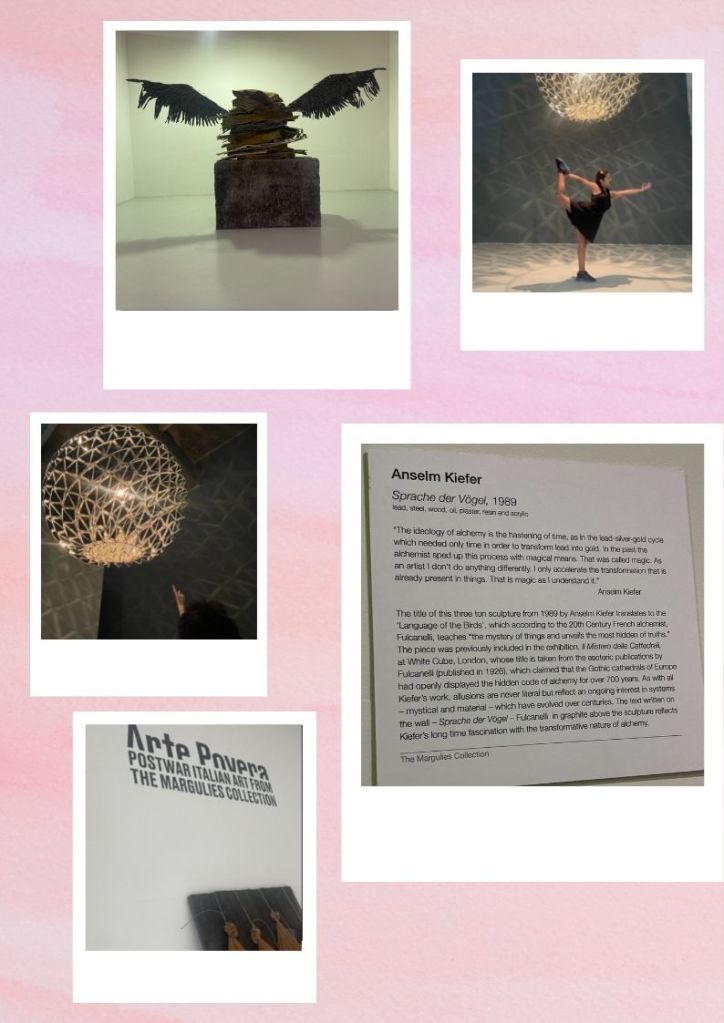
“A Pillar of the Community”
By Catherine Carrasco of FIU at the Wynwood Arts District, 20 March 2022
The Marguiles Collection at the Warehouse is a nonprofit organization located in Wynwood and belongs to contemporary art collector Martin Z. Margulies. The exhibitions found at the Warehouse are breathtaking. However, learning about the founder himself was most profound for me.
The Warehouse first opened in 1999, hosting a benefit for a local museum; since then, the exhibitions have expanded and opened to the public. Florida students are granted entrance free of charge as part of the founder’s mission to make education in contemporary art accessible to the community. In addition to guiding tours whenever he’s in town, Martin Marguiles donates or gifts many collection pieces to museums or academic institutions. Establishments such as The Studio Museum in Harlem, The Met, Florida International University, and the University of Miami have all been recipients of the loans. For example, “Argosy” by Alexander Liberman was donated to FIU until President Rosenberg returned the sculpture in 2015.
Martin’s dedication extends past the world of art and education as he is also the founder of the Lotus House located in Overtown. His devotion to the community has made the shelter the largest in the country, serving women and youth. Besides providing a temporary home for these families, the foundation offers health services, enrichment programs, education, and job training to prepare them further to acclimate to their local communities in the healthiest ways possible. In 2015, the nonprofit organization raised over six figures during Art Basel and donated all proceeds to the Lotus House. While researching his life further, I thought his philanthropic work and thoughtfulness towards our communities to be the most admirable.
“Donations to Educational Institutions.” Margulies Collection, https://www.margulieswarehouse.com/about.
Boucher, Brian. “Amid Miami Excess-Margulies Collection Aims to Help the Needy.” Lotus House, Sundari Foundation Inc, Dba Lotus House, 1 Dec. 2015, https://lotushouse.org/amid-miami-excess-margulies-collection-aims-to-help-the-needy/. Accessed 20 Mar. 2022.
“The One and Only Martin Z. Marguiles.” Marguiles Warehouse, The Canvas Monthly, n.d., https://www.margulieswarehouse.com/attachment/en/5e14ec99a5aa2c4d308b4567/News/581bbd0ae6aa2cf511eea25d. Accessed 20 Mar. 2022.
Piccardo, Rebeca. “Argosy sculpture to be returned after renovations” The Beacon , Fiusm.com, 12 Jan. 2015, http://dpanther.fiu.edu/sobek/content/FI/14/04/10/00/00481/FI14040481.pdf. Accessed 20 Mar. 2022.
Coconut Grove as Text

“Racial Wealth Disparity at The Grove”
By Catherine Carrasco of FIU at The Barnacle Historic State Park & Evangelist Street, 23 March 2022
Upon researching Miami, I’ve found many families described as the original homesteaders with last names, such as Munroe, Peacock, and Brickell. However, the Grove initially was inhabited by Bahamian settlers whose history isn’t frequently recognized. Unfortunately, the lack of historical preservation due to racial and wealth disparity is a sad reality still relevant today. Therefore, while my reflection began as a study on The Barnacle Historic State Park, I find it essential to mention that the area was home to other communities long before some of the families now documented as pioneers moved to the site. Undoubtedly, Bahamians and tribes such as the Tequesta and Seminoles played a crucial role in Miami and what it is today.
In the 1800s, the area of Coconut Grove was home to the Kebo community, mostly made up of Blacks who had migrated from the Bahamas. The Bahamian neighborhood established churches, education for children, and even set up a cemetery. At the time, the cemetery was one of the only places blacks were allowed to bury their deceased friends and families, the Charlotte Jane Cemetery. The cemetery named after E.W.F. Stirrups’ wife is on Charles Avenue, where a burial style from the Caribbean is practiced, with tombs above ground.
In 1886, Ralph Middleton Munroe purchased 40 acres on Biscayne Bay after a chance encounter with William Brickell in his home state, New York. Ralph was a sailboat designer, photographer, and naturalist. The land, now known as The Barnacle Historic State Park, cost $400, and one of the designers’ sailboats. As Henry Flagler moved to expand his railroad down South, Ralph was one of the few community members who fought to preserve the area as it was. Although the family opposed the impending change, the surrounding locations quickly transformed. Ultimately, to avoid the destruction of the land, the family sold it to the State of Florida. Due to its preserved nature, a walk through the park grants glimpses into the early days of Biscayne Bay, expressing a serene atmosphere.
Here, guests find one of the oldest homes in Miami still in its initial location. The home built in 1891 was once a one-story bungalow whose roof resembled a barnacle hence the park’s name. After his first wife died tragically of tuberculosis, Ralph married Jessie Wirth. The collage above shows Jessie with their two children, Patty and Wirth. As the Munroe family grew, the designer expanded the home by placing the first floor on stilts and adding a new first floor, making it a distinctive structure in South Florida. Yet, nearby the Barnacle is Evangelist Street or Charles Avenue, where the home which belonged to Mariah Brown, a Bahamian settler, still stands. The mother of 3 purchased it for $50 in 1890 from Joseph Frow. It is awe-inspiring to learn a woman of color was capable of achieving what Mariah Brown did during a time of racial segregation. However, no tour guides are found here, no one seems to keep up the land, and the home itself appears to be falling apart, unlike those of the wealthier “pioneers” credited with the creation of Miami.
Historic and Environmental Preservation Board. “Evangelist Street/Charles Avenue.” Historic Preservation Miami, The City of Miami, http://historicpreservationmiami.com/pdfs/Evangelist%20Street%20-Charles%20Avenue.pdf.
Historic Association of Southern Florida. “Update: The Barnacle.” History Miami Museum, History Miami, http://www.historymiami.org/wp-content/uploads/documents/update-v4-n5.pdf.
Dade Heritage Trust. III. HISTORICAL CONTEXT DEVELOPMENT OF COCONUT GROVE (1880s –1920s). Dude Heritage Trust, https://dadeheritagetrust.org/wp-content/uploads/2021/07/KIEHNEL_FINAL_ll.pdf.